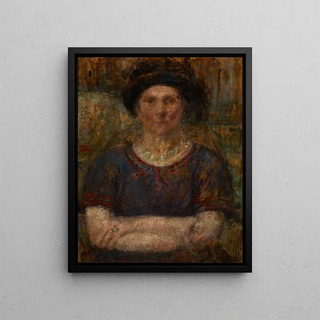Art print | Portrait of Mrs. Bankiewicz - Olga Boznańska


View from behind

Frame (optional)
Portrait of Mme Bankiewicz - Olga Boznańska – Captivating Introduction
The "Portrait of Mme Bankiewicz" by Olga Boznańska is an iconic work that embodies the very essence of early 20th-century portrait painting. Created in 1898, this art print captures with unparalleled finesse the beauty and complexity of her model, Madame Bankiewicz, while revealing the artist's technical mastery. Through this piece, Boznańska transports us into a universe where intimacy and emotion intertwine, offering a window into the soul of her subject. The way she plays with light and shadow creates an atmosphere that is both gentle and melancholic, inviting the viewer to immerse themselves in the gaze of the depicted woman.
Style and uniqueness of the work
Olga Boznańska's style is distinguished by a delicate and subtle approach, blending realism with impressionist sensibility. In the "Portrait of Mme Bankiewicz," the color palette chosen by the artist evokes a delicate harmony, with pastel tones enveloping the subject in an aura of serenity. This art print is also characterized by a carefully balanced composition, where Madame Bankiewicz's facial features are rendered with remarkable precision. Details such as reflections in the eyes and the texture of the clothing reveal meticulous attention to each element. The model's posture, both natural and elegant, suggests introspection, as if she were lost in her thoughts. This blend of technique and emotion makes this work a true masterpiece, capable of touching hearts and awakening minds.
The artist and her influence
Olga Boznańska, a key figure in Polish art, established herself on the European artistic scene thanks to her exceptional talent and unique style. Born in 1865 in Kraków, she was influenced by Impressionist and Post-Impressionist currents, while developing her own distinctive voice. Her ability to capture the nuances of the human soul through portraiture made her a pioneer in her field. Boznańska was also a woman

Matte finish

View from behind

Frame (optional)
Portrait of Mme Bankiewicz - Olga Boznańska – Captivating Introduction
The "Portrait of Mme Bankiewicz" by Olga Boznańska is an iconic work that embodies the very essence of early 20th-century portrait painting. Created in 1898, this art print captures with unparalleled finesse the beauty and complexity of her model, Madame Bankiewicz, while revealing the artist's technical mastery. Through this piece, Boznańska transports us into a universe where intimacy and emotion intertwine, offering a window into the soul of her subject. The way she plays with light and shadow creates an atmosphere that is both gentle and melancholic, inviting the viewer to immerse themselves in the gaze of the depicted woman.
Style and uniqueness of the work
Olga Boznańska's style is distinguished by a delicate and subtle approach, blending realism with impressionist sensibility. In the "Portrait of Mme Bankiewicz," the color palette chosen by the artist evokes a delicate harmony, with pastel tones enveloping the subject in an aura of serenity. This art print is also characterized by a carefully balanced composition, where Madame Bankiewicz's facial features are rendered with remarkable precision. Details such as reflections in the eyes and the texture of the clothing reveal meticulous attention to each element. The model's posture, both natural and elegant, suggests introspection, as if she were lost in her thoughts. This blend of technique and emotion makes this work a true masterpiece, capable of touching hearts and awakening minds.
The artist and her influence
Olga Boznańska, a key figure in Polish art, established herself on the European artistic scene thanks to her exceptional talent and unique style. Born in 1865 in Kraków, she was influenced by Impressionist and Post-Impressionist currents, while developing her own distinctive voice. Her ability to capture the nuances of the human soul through portraiture made her a pioneer in her field. Boznańska was also a woman






